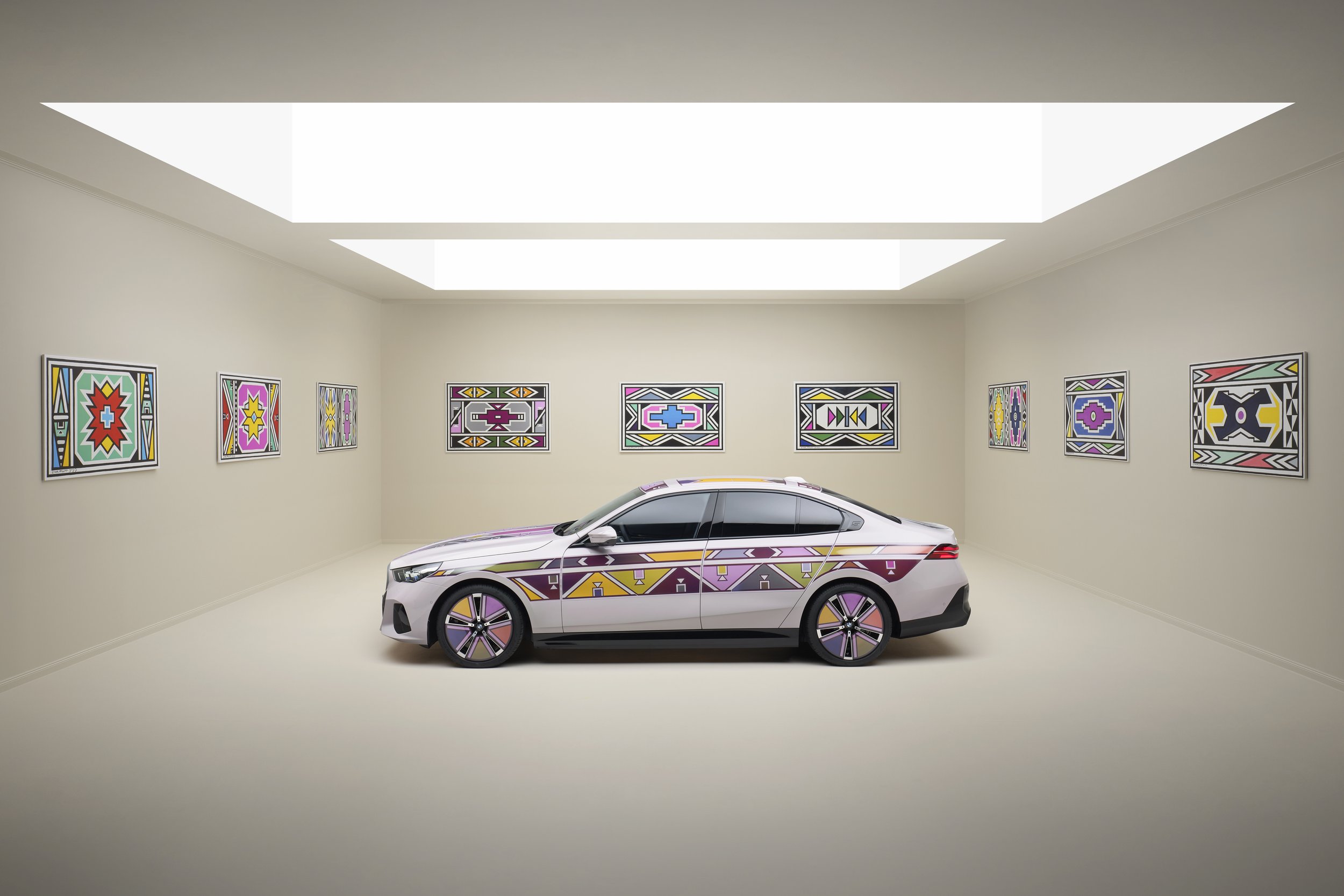Esther Mahalangu: A Pioneer in Contemporary Art Inspires Tech Innovation
Esther Mahlangu’s 1991 BMW Art Car is reimagined for the Digital future as her first career retrospective opens at the iziko South African National Gallery
Photo: Le Car
When Esther Mahlangu arrived at the opening of her retrospective “Then I Knew I Was Good at Painting” at the Iziko south African National Gallery in Cape Town her presence transformed the room. On stage, a parade of dignitaries spoke including representatives from the government, the BMW South Africa CEO, and the exhibition curator, who all paid tribute to her pioneering role in contemporary art — and her ongoing impact. Mahlangu’s work will be featured at the upcoming Venice Biennale and is the subject of a new book Esther Mahlangu: A Life in Color.
In response Dr. Mahlangu contributed a warm, yet concise welcome to the international media, choosing to stay seated among the audience, and to let her work speak for itself. “Hello people! How are you?” she said and promptly handed the microphone back to the presenter. Dr. Mahlangu may have had few words to share, but the joyful tamber of her tone was undeniable. The show is her first major retrospective exhibition, held in South Africa, the country of her birth, and where she still lives and works at age 88.
At the exhibition preview that evening Dr. Mahlangu glided through the room, dressed in bright red, blue, orange, and green, in the style of the Ndebele people and a reference to the culture that is at the heart of her life’s work. The exhibition, curated by Nontobeko Ntombela, features 100 works that range from both large and small works on canvas to objects such as a pair of delicate high heel shoes, a decorative skateboard, and a full-size sedan. Mahlangu’s painting style projects modernity, as geometric shapes zig and zag in formation. The exhibition, made up of much later career work, illustrates Mahlangu’s consistent ability to work across various sizes, scale, and dimension. In this setting, the museum galleries transformed into what felt like being inside of an immersive Mahlangu mural, a cornucopia of vivid colorful shapes, contrasted by cascading white lines.
“Painting is a part of me, and it always will be.”
Wall text and installations included biographical references to her early work as a muralist in Mpumalanga, the rural region over 1000 miles northwest where she still lives in a home adorned with one of her murals. For young people to carry on the Ndebele tradition, Mahlangu built out an art school in her backyard that she self-funded to teach the techniques of Ndebele painting and design, inspiring the next generation of Ndebele artists, some of whom have also started to work on canvas, expanding the lexicon.
“I am pleased to see my works and practice recognized with a museum show of this type,” she said a few days after the opening in an interview. “This show will contribute to my legacy and my wish that my artworks and Ndebele design should not be forgotten.” The works are on loan from collections around the world, one indicator of Dr. Mahlangu’s international stature.
Mahlangu, born in 1935, started painting at ten years old in the rich tradition passed down among women in her community, where murals are a cultural expression that mark special occasions. She studied the work her grandmother and mother painted on the surface of the home and she practiced painting with a brush made of chicken feathers when no one was looking. In its earliest form, Ndebele women used soil, water, and cow dung for pigmentation in murals, a palette that expanded as new materials and acrylic paints became accessible. While the back of the home was typically painted in muted tones, the front of the home was reserved for the most elaborate, colorful compositions. When her elders finally invited Mahlangu to paint the front of the home, she knew she had arrived as an artist. The curator Ntombela cited this recollection as inspiration for the show’s title in her remarks. “I was asked to come to the front of the house,” Mahlangu said in a passaged captured on the wall text. “I knew I was good at painting.”
Photo: Le Car
In 1986, an era in which South Africa was still firmly under the grip of apartheid policies, a group of French historians visited Mpumalanga and took documentary photos of the mural that adorned Dr. Mahlangu’s home. At the time, Mahlangu worked as a painter at Bothshabelo Historical Village, a local site dedicated to Ndebele culture. Her work already carried forward the traditional techniques of her culture infused by new paint colors and experimentations with line and composition. The photographs inspired her first global commission to paint a traditional Ndebele-style freestanding mural on a constructed home for a Paris exhibition in 1989. “I started painting around 1945 when I was 10 years old. It was only in 1989 when I was invited to participate in Les Magiciens de la Terre in Paris that I had my first major international exposure,” she said. Then in 1991, BMW selected her as the twelfth art car artist, a prestigious honor that made her part of a class of renowned artists including Alexander Calder, Roy Lichtenstein, and Andy Warhol. Dr. Mahlangu was both the first African and the first woman commissioned to create a BMW art car, which was later shown at Documenta 9. The back-to-back commissions altered her trajectory. “The response to this exhibition and my BMW Art Car in 1991 made is it clear to me that there was major interest in my works from international audiences and I continued to travel and collaborate with different people and entities ever since.”
BMW engineer Stella Clarke and Esther Mahlangu. Courtesy: Esther Mahlagu and BMW
Mahlangu’s 1991 BMW 521i art car is a standout in the prestigious collection, infusing traditional Ndebele elements and has led to subsequent work with BMW, including a new commission revealed by BMW executives at the late February preview of Frieze Los Angeles in celebration of her ongoing retrospective. She worked with engineers to create the final product, the BMW i5 Flow NOSTOKANA, named for Mahlangu’s first son, animated in e-ink film across the hood, roof, and rear of the car. She is the first artist to lend her work to this cutting-edge industrial application of future auto tech. The installation is accompanied by the sound of Mahlangu’s voice, and the soft whisk of the feather brushes she uses.
“I have always been open to and enjoyed collaborations and exploring new mediums and technologies,” she said. “We used to paint murals using natural pigments. When new paints were developed, we used those as they lasted longer and allowed for more options in terms of colors and now it makes sense to explore new mediums that would allow my artworks to be shown in different ways to larger global audiences.”
Esther Mahlangu’s 1991 BMW 525i Art Car inspires the animated experience of theBMW i5 Flow NOSTOKANA exterior. Photo: BMW, courtesy Esther Mahlangu.
Her approach to painting from two to the three-dimensional object is revealing on how she alters her process to adapt her technique to work on variable surfaces. The vehicles she has painted are one example. "I painted the car like a wall, and for the Ndebele people, if you begin to paint a wall, it means you’re announcing either a wedding or a celebration. When you start to paint, they know that something big is going to happen."
Dr. Mahlangu continues to travel and to build her body of work. “The process is similar whether I paint a car or a canvas or a wall. I first consider the medium on which I intend painting and conceptualize an artwork that would work on that space.” While Mahlangu’s trajectory hasn’t followed a prescribed pattern, it’s notable that many of her various commissions predate the art world trend to work in collaboration with brands. She’s also collaborated with John Legend on a Belvedere Vodka bottle, customized a British Airways plane, and in 1992, she designed show rooms for the fashion brand Commes des Garcons.
“ Exhibitions dedicated to groundbreaking African modernists like Esther are important and long overdue.”
"Exhibitions dedicated to groundbreaking African modernists like Esther are important and long overdue,” said Osei Bonsu, Curator of International Art at Tate Modern, art historian, and the author of "African Art Now: Fifty Pioneers Defining African art for the Twenty-first Century." “At Tate Modern, we have been steadily building the representation of such artists through dedicated displays and exhibitions since 2012 with Ibrahim el Salahi's major retrospective. It's important, however, that we give each artist the proper historical and cultural context their work has often been denied. As with so many artists, including Esther, the roots of artistic tradition, exchange and community require further and deeper exploration."
The flurry of recent attention, inclusion in institutional shows such as the current “Giants: Art from the Dean Collection” at the Brooklyn Museum, and awards such as a 2019 honorary doctorate from the University of Johannesburg indicate that much more is ahead to contextualize Mahlangu’s contribution to contemporary global art. But Mahlangu is by no means done working. “Painting is a part of me, and it always will be,” she said. “I only want to stop creating when I no longer am able to do so.”




